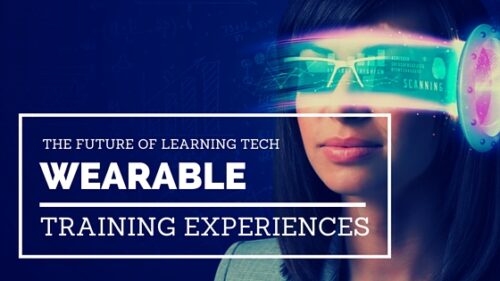Future eLearning Tech 2016: Wearable Training Experiences
As 2016 quickly approaches we all look into our crystal balls and pontificate about the coming year. Whether we do it in a blog, or during New Years parties, or just thinking to ourselves, it’s an exercise in hoping for a better tomorrow. The L&D world can participate in this annual custom, but it can rarely act on it. As the lagging indicator of the tech world, the future of education and L&D often looks like the old tech rather than new tech. But that doesn’t mean we can’t enjoy the excitement of newly revealed tech gadgetry. It simply means that when the tech world is thinking about the new year of new tech, the greater L&D community will be viewing the same tech through a 5-10 year lens.
With that being said, it’s still fun to get an early look at what the training experience of tomorrow will look like today.
Wearable Sports Training
One of the hottest trends in the internet of things (IoT) is wearable tech. It’s a trend that is already available, but remains a little clumsy and mostly priced outside the budget of the average consumer. The Fitbit, Apple Watch, and other activity tracking devices have been the most successful wearable tech. And while they are really good at collecting data, their intended purpose is to change behavior. Hey, isn’t that what we strive for? Sure it is. We should be thinking about wearable tech as a viable training technology.
Wearable technology at this point is nothing more than a bulky attachment to our bodies or clothing. Tomorrow’s wearable technology will be embedded in the clothing and unobtrusive. We won’t even know it’s there. And it will gather data well beyond heart rate, and number of steps.
The natural market for the growth of wearable tech has been in sports and fitness. The same holds true for clothing with embedded tech. However, companies are beginning to experiment with other markets like ergonomics and personal development/improvement.
Imagine a manufacturing employee in wearable tech that tracks precise movements, posture, and environmental conditions. Many jobs still require repetitive movements throughout a given work shift. Even white collar jobs are subject to repetitive stress injuries. Today we do our best to “require” ergonomics training for all employees in an effort to reduce “days away from the job due to injury or illness”. But why not let technology monitor this as well, and cue us to change our behavior?
Lumobodytech.com is working on this problem with their innovative Lumo Lift product. A heading on their website reads, “Solving back pain through elegant sensing and custom coaching.” The small device works attached to your shirt and mildly vibrating as you slouch or otherwise relax into poor posture. The vibration is your cue, or trigger, to adjust into a healthier posture. Their clothing line specifically for running will launch first as shorts for men and capris for women with the tech embedded in the clothing. The data gathered from their clothing is well beyond what you would get from a wrist band device. Check it out at their website, and then imagine the training opportunities.
Wearable Virtual Reality Suit
Most virtual reality to date is an experience of immersive interactive 3D. The real virtual reality of the future involves so much more. Instead of viewing an environment on a screen and imagining being there, virtual reality puts you into a simulated environment that you can see and feel. Advances in haptic suits are making the future of VR a reality. If you’ve read the books Ready Player One, or the older Snowcrash, you know exactly what I’m talking about. The virtual reality imagined in those books is becoming our reality with products like TeslaSuit.
Brian Daly is a UK Department of Education Consultant who has experienced the Teslasuit and gives his feedback in this 30 second video.
The range of educational possibilities is limitless. We won’t see haptic suits in corporate training any time soon. But we can watch and learn from those industries on the bleeding edge of haptic suit commercialization like gaming, military training, sports, and healthcare.
The technology is not what holds back the L&D community. It’s the culture of technology usage that lags behind the technology. The good news is that this lag gives us time to look more deeply into the learning applications of new tech. The rapid growth of computer-based training in the ‘90s taught us a valuable lesson in the importance of people over technology in our process of training. If the people we are charged with training are not familiar with a technology and currently using it in their daily lives, it often complicates the learning process. The extensive focus required to teach the technology before applying the technology to learning can be an expensive endeavor. In some cases the expense and time is worth the effort. As in the case of military training simulations, or surgical simulations. But in the case of corporate training, the return on investment is just not there…yet.
Next week the annual pilgrimage to Las Vegas by the technology community known as CES (Computer Electronics Show) begins. I will be Periscoping, blogging, vlogging, tweeting, instragraming, from the event and hope you will join me virtually on any of these platforms. If there is something you’re interested in hearing about, please feel free to reach out and let me know @Litmos.






